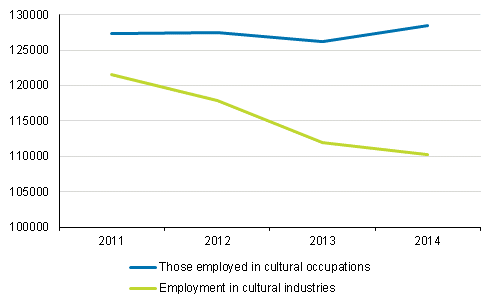Published: 27 August 2015
Employment has weakened in cultural industries
Cultural industries employ ever fewer people but the employment of those working in cultural occupations has remained stable from 2011 to 2014.
Employment in cultural industries has weakened by over nine per cent from 2011. Employment decreased most in publishing, by over 30 per cent. From 2013 to 2014, employment in the industries weakened by nearly one-and-a-half per cent.
Employment among those working in cultural occupations has improved by one per cent from the level of 2011.
The average number of those employed in cultural industries was in 2014 around 110,000 and over 128,000 employed persons were working in cultural occupations.
Employed persons in cultural occupations and industries in 2011 to 2014

Cultural industries also employ others than those working in cultural occupations. In addition, those employed in cultural occupations can find employment elsewhere than in cultural industries and they also include a large number of self-employed people.
Of occupations, employment deteriorated most, by nearly 30 per cent, for architects and product and clothing designers, as well as community and traffic planners. Compared to 2011, 27 per cent fewer were also employed in the occupations of public relations professionals, curators, archivists and librarians and related information specialists. The number of journalists dropped by 12 per cent. Employment among those working in advertising and marketing occupations appears to have improved substantially. However, the change is at least partly caused by changes in classifications and methodology. Employment among artists and authors improved by nine per cent. The Labour Force Survey collects statistical data on the participation in work, employment, unemployment and activity of persons outside the labour force among the population aged between 15 and 74.
The Labour Force Survey data collection is based on a random sample drawn twice a year from Statistics Finland’s population database. The monthly sample consists of some 12,000 persons and the data are collected with computer-assisted telephone interviews. Based on the information provided by the respondents, a picture emerges of the activities of the entire population aged between 15 and 74. A person is employed if he/she has during the survey week been in gainful employment for at least one hour against pay in money or fringe benefits, or to make a profit, or has been temporarily absent from work. Persons absent from work during the survey week are classified as employed if the reason for absence is maternity or paternity leave or own illness or the absence has lasted for under three months. Employed persons can be employees, self-employed or unpaid workers in enterprises of a family member. The concepts and definitions used in the survey comply with the recommendations of the ILO, the International Labour Organisation of the UN, and the regulations of the European Union on official statistics. The current data content of the Labour Force Survey is mainly based on the EU Regulations concerning Labour Force Surveys (577/98, 2257/2003 and 430/2005). A detailed description of the EU Labour Force Survey is available at: http://epp.eurostat.ec.europa.eu/portal/page/portal/employment_unemployment_lfs/introduction
Source: Cultural statistics 2014, Statistics Finland
Inquiries: Kaisa Weckström 029 551 2348, kulttuuri.tilastokeskus@stat.fi
Director in charge: Riitta Harala
Publication in pdf-format (270.7 kB)
- Reviews
-
- 1. Persons employed in cultural occupations as their main job according to the Labour Force Survey (27.8.2015)
- 2. Persons employed in cultural occupations as their main job according to employment statistics (27.8.2015)
- 3. Definition of culture from the data file (27.8.2015)
- 4. Data and classifications (27.8.2015)
- Tables
-
Tables in databases
Pick the data you need into tables, view the data as graphs, or download the data for your use.
Appendix tables
- Figures
Updated 27.8.2015
Official Statistics of Finland (OSF):
Culture [e-publication].
ISSN=2341-7404. Cultural Employment in Finland 2014. Helsinki: Statistics Finland [referred: 18.12.2025].
Access method: http://stat.fi/til/klt/2014/01/klt_2014_01_2015-08-27_tie_001_en.html

